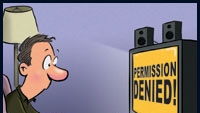Dam DRM

If you are the parent of two or more kids, you've probably heard the following argument at one time or another. “It's mine. No it's not; it's mine,” as the children argued about the ownership of some toy. Well, it looks like we adults could be facing a similar argument when it comes to our music and video entertainment.
New digital asset management systems are providing content holders with the ability to literally turn on and off your rights to enjoy the entertainment you thought you owned.
The first evidence of the building battle between rights holders and consumers was the announcement that Real Audio had found a way to circumvent Apple's copy protection scam, I mean scheme. Real claimed it was only allowing the “consumer [to] buy music once and play it anywhere.” Clearly, that was not what Apple intended.
Apple's iTunes prohibits downloaded tunes from playing on more than five devices. Each downloaded iTune is encoded with a DRM code that tracks on how many computers (players) you've loaded the tune. Before you can load the tune on a sixth player, you have to run the DRM software to de-authorize that particular tune from one of your players.
The whole rights issue has proven to be a bonanza for attorneys and a boondoggle for consumers. In the USA, hundreds of consumers have been sued by the Record Industry America Association (RIAA) for, as it puts it, “illegally downloading music.” In Europe, many CDs now contain anti-copy protection DRM.
Similar rights issues are at play with DVDs and will be especially important with the new HD-DVDs and Blu-Ray HD DVDs. The question will then become: Do consumers really own their copy of Monty Python, or will they simply have the right to view it once or twice before they are locked out?
While today's DVDs already have DRM restrictions, most consumers never encounter them. They exist in the form of geographic restrictions. Try playing a DVD you bought in the USA in your French DVD player, and you're stuck. It won't play.
Get the TV Tech Newsletter
The professional video industry's #1 source for news, trends and product and tech information. Sign up below.
I hadn't given this issue much thought until last night when I decided to finish a movie I had rented via PPV from my cable system. I sat down with my favorite adult beverage and pressed play. Instead of the movie picking up where it left off, a new “Authorize payment” screen appeared.
Wait a minute! It hadn't been 24 hours since I stopped watching the movie at about 22:00. It was now only 20:05. I figured I still had almost two more hours to finish the movie.
That's when I first realized that the DAM PPV timeframe was measured from the time you start the movie, not when you stop watching the movie. If I wanted to see the end of the movie, I had to pay another €5. Call me cheap, but I still haven't seen the rest of the movie.
We consumers are about to be unpleasantly surprised as more DRM schemes like that suddenly pop up with our entertainment. However, content makers would be wise not to be too selfish with viewing rights, or they may hear the echo of consumer's sentiments, “Dam DRM.”
Send comments to: • editor@primediabusiness.com • www.broadcastengineering.com
